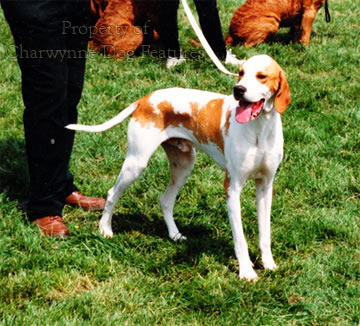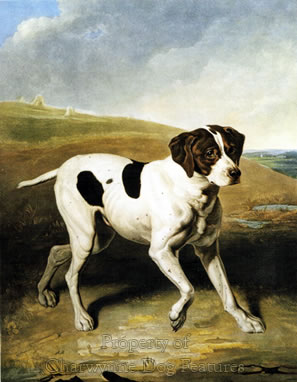879 THE DANGER OF THE FAT LABRADOR
THE DANGER OF THE FAT LABRADOR
by David Hancock

 Over the last 40 years, in a number of sporting magazine articles, I have striven to highlight the perils of tolerating gundogs that have two crucial failings: a lack of a weatherproof coat and a lack of condition. On the latter point, I find owners self-conscious about their fat Labrador but rarely strong enough to remedy the situation. More and more each year I come across gundogs - some that are used on shoots - that not only lack hard muscle but carry superfluous weight. A fat Labrador is a sad sight; an overweight German HPR looks like a betrayal of all those breeds' founders' work, especially in the Weimaraner but a podgy Pointer is just a disgrace. Every portrayal of the Pointer of England in past centuries and every photograph of them in the field in the last century depicts a muscular dog, with good tuck-up, well-developed loins and strong limbs. I don't recall seeing such a dog early in this new century. I pray there are plenty I just haven't come across. I do see handsome statuesque specimens at KC shows but they rarely have a hard muscle between them! Are skinny, sighthound-like Pointers being tolerated as much as fat Labradors? Every gundog breed has to be strongly-constructed and at a 'fighting weight'.
Over the last 40 years, in a number of sporting magazine articles, I have striven to highlight the perils of tolerating gundogs that have two crucial failings: a lack of a weatherproof coat and a lack of condition. On the latter point, I find owners self-conscious about their fat Labrador but rarely strong enough to remedy the situation. More and more each year I come across gundogs - some that are used on shoots - that not only lack hard muscle but carry superfluous weight. A fat Labrador is a sad sight; an overweight German HPR looks like a betrayal of all those breeds' founders' work, especially in the Weimaraner but a podgy Pointer is just a disgrace. Every portrayal of the Pointer of England in past centuries and every photograph of them in the field in the last century depicts a muscular dog, with good tuck-up, well-developed loins and strong limbs. I don't recall seeing such a dog early in this new century. I pray there are plenty I just haven't come across. I do see handsome statuesque specimens at KC shows but they rarely have a hard muscle between them! Are skinny, sighthound-like Pointers being tolerated as much as fat Labradors? Every gundog breed has to be strongly-constructed and at a 'fighting weight'. 
A regular comment from today's show ring judges on the gundog entry is the exhibiting of overweight dogs, especially Labradors. Obesity in any working dog is a sin and any sensible judge should send such a dog to the back of the class, however shiny the coat. Labradors have long been known to be "gross feeders", liable to put on flesh. Being overweight inhibits field performance and places needless extra demands on the heart of the dog. Extra demands are also made by the construction faults listed even by the Crufts judges. Unsound movement, especially when rooted in incorrectly placed shoulders which limits endurance through the additional strain imposed on the forequarters. Setters can be racey but should never lack muscle-tone. Strength in the back and limbs is fundamental for stamina on a long day in the shooting field. Such basic faults are of course present too in working dogs but no sensible owner breeds from such stock. Winners at Crufts produce scores of offspring.
For the owner of even a show gundog not to keep his dog in good physical condition is a betrayal of the working origin of the breed. Crufts judges's reports in the recent past on Field and Clumber Spaniels respectively read: "...many were shown carrying too much weight" and "I felt many were in soft condition..." This source of criticism from show ring judges on gundog breeds is not restricted to Crufts; at the North West Labrador Club's Championship show a few years back, the judge reported: "There can't have been more than 20 bitches (in a high entry) who were a suitable weight for a working breed." At the 2012 Manchester Championship Show, the Flat-coat judge reported, after lamenting the lack of hindquarter muscle: “Several really nice dogs were shown overweight…” Obesity, however undesirable in a gundog breed, is easily rectified, faulty movement indicates faulty construction, which is much more worrying.
When I was making a commercial video on the Labrador Retriever some years ago, I had the pleasure and privilege of seeing the dogs in the kennels of the late Gwen Broadley and, later, of Carole Coode. It was abundantly clear that both these breeders had a very clear idea of what an outstanding dog in their breed should look like. I think of them when I see overweight faulty Labs at shows and in the park. I am old enough too to recall the consistently-high quality of the 'of Ware' Cockers and the Whitwell Pointers. Top quality dogs can be truly inspiring. But you shouldn’t have to rely on your memory to be conscious of top quality gundogs, they should be all around you – from inspired breeders, identified by competent judges and valued by experienced sportsmen. A Labrador should never have to 'waddle' to cope with excess weight; a Pointer should never resemble a flighty Greyhound; both should display 'condition'. At dog shows the exhibitors are expected to present their entries in 'show condition'.
But what is actually meant by the expression 'show condition'? The Kennel Club's Glossary of Terms defines condition as: "Health as shown by the body, coat, general appearance and deportment. Denoting overall fitness." Not brilliantly written but the last phrase is the key one. Frank Jackson, in his most useful "Dictionary of Canine Terms", defines condition as: "Quality of health evident in coat, muscle, vitality and general demeanour." Harold Spira, in his "Canine Terminology", describes it as: "An animal's state of fitness or health as reflected by external appearance and behaviour. For example, muscular development..." The Breed Standards and Stud Book Sub-Committee at the KC inform me that show condition indicated an expectation of "a dog in good health as indicated by good coat condition, good muscle tone, a bright eye and up on the feet", adding that any competent judge would know this. One thing is inescapable in the interpretation of these definitions, condition means fitness as demonstrated in the dog's muscular state.
For any gundog breed to lack a working physique is disappointing to say the least; are we promoting glamour ahead of soundness? Dogs don't care what they look like, but they do suffer distress when we expect them to run and run with little lung-room in their thoraxes, limited forward extension in front and a lack of power from the rear. A Pointer judge reported in a recent critique: "The breed as a whole now seems to be suffering from poor hindquarters, ranging from straight stifles, no definition of hock joint, hocks set too high, poor width of thigh, steeply sloping croups...if we lose the powerful back-ends our Pointers will no longer have the drive to propel them over the moors and stubble fields to enable them to do the job for which they were bred." Should we not value the working anatomy? Are we not devaluing their sporting heritage?
It is difficult to identify the logic in favouring a breed designed for a specific purpose, and therefore having the anatomy suitable for that, then breeding specimens to an alien design. Many Pointers that I see, even at Crufts, are quite unlike those depicted in past centuries; they lack substance, physically they are not sound gundogs, with narrow chests, straight shoulders and poor movement. This saddens me, these were once superlative hunting dogs, famous in many countries for their prowess in the shooting field. I once watched a Pointer win at Crufts with a Hackney action, a feature forbidden in its breed standard. This is a standard that uses just three words on the stifles, stating that they must be 'well-turned'. Is such judging and such a word picture helping this distinguished breed? Are we devaluing their function?
The great Pointer expert, William Arkwright, in his The Pointer and his Predecessors, of 1906, wrote: "The Stifles, extending from the stifle-joint to the hock, must be well bent, since on the length of the outline of his hindquarters, between the hip-bones and the hocks, will depend the endurance of the dog, as this formation, in conjunction with an arched loin, gives the maximum of speed with the minimum of labour..." I find those words valuable. Does anyone value endurance in their gundogs anymore?